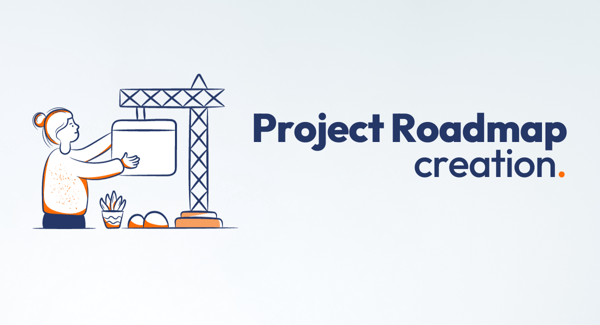Share this
How to Create the Perfect Project Roadmap in 5 Easy Steps
by Jarno Koopman on January 1, 1970

As we all know, some projects are more challenging than others. When it comes time to begin your planning, some assignments can leave you scratching your head about where to even start.
A project roadmap is a simple project management document that can help you get focused and stay organized. It’s also an effective way to figure out timelines and what priority you’ll need to give each phase.
Before moving forward with detailed project planning, a roadmap will help you outline the big picture of the project lifecycle for team members and stakeholders.
Find out more and check out our tips for creating the perfect project roadmap in a jiffy.
What is a project roadmap?
A project roadmap is a visual tool that displays an overview of your project objectives and deliverables against a timeline. The project roadmap will show the basic flow of the project lifecycle, including sequential phases and dependencies.
What it’s used for
Your project roadmap won’t be the same as your project planning, say with a Gantt chart. (Although many project roadmaps use the Gantt chart layout.)
Instead, a roadmap shows a more high-level perspective of the project lifecycle and the major steps it will take to reach the final destination. This makes it a valuable tool for communicating the basic objectives with multiple stakeholders and teams.
Benefits of making a project roadmap
The project roadmap should give everyone a solid idea of the project scope, without getting too granular. In a nutshell, creating a functional project roadmap will help you to:
Present a visual of the project scope - Whoever needs to get a macro representation of the project scope can get it with this one-page visual.
Clarify strategy - Your roadmap enables you to clarify strategy with your team by examining goals and deliverables against the timeline.
Manage expectations with stakeholders - With a project roadmap, stakeholders can clearly see an outline of execution within the project lifecycle, making dissatisfaction less likely later on.
Get your ducks in a row for planning - The project roadmap is a great precursor, an outline to inform official planning that acts as a catalyst to get things moving forward.
Prepare your team - Team members can understand the basics of what work on the project will look like, how it will affect them, and what will be required.
See where your priorities lie - Seeing a high-level view of the project cycle can help you identify which tasks and stages deserve highest priority.
Pinpoint possible vulnerabilities - On the flip side, you’ll be able to get an idea for possible weak points where work could get clogged.
Coordinate with outside teams - If you need to bring in an outside team, the project roadmap is an excellent document to give them a good idea of what to expect.
What’s included in a project roadmap
The project roadmap should be clear and concise, serving more as an outline than a detailed plan. Before you dive in, think about the following components and how your project is going to look against a timeline. Here’s what should be included in the visual:
- Project objectives - What is/are the primary goal/s?
- Deliverables - What are the deliverables that contribute to the final result?
- Milestones - What are the key lynchpoints that once complete, propel the project into the next phase?
- Project timeline - How long will the project take? About how long for each phase/deliverable?
- Dependencies - Are there phases that cannot begin until other phases are complete?
- Contact information - How can you contact the project manager? Get a hold of each team lead?
Make a project roadmap in 5 easy steps
Before you begin, remember that a project roadmap should be both concise and flexible. Therefore, don’t be tempted to get into the nitty gritty. Instead, focus on providing the basic info that you would want to know if you were on the team or a stakeholder.
Also, you don’t have to know everything down to a tee (i.e. specific dates, etc) about the project before you make a project roadmap. It can be a flexible document before you get input from others, so don’t stress about making it perfect.
1. Start with a template or spreadsheet
To get started on your project roadmap, you’ll need something to build your visual, like Google Sheets or Excel.
You can go it alone and make one from scratch (not difficult), but it’s quicker to work with a template. See this FREE Sheets template or this FREE project roadmap Excel template if you need a jump-off point.
2. Populate your roadmap with details
Now, you’ll enter the details discussed above that pertain to the basic structure of the project. On the left side of the roadmap, you’ll put the project into phases, objectives, and/or workstreams, i.e. marketing, development, etc.
Next, move from left to right across the timeline to input the necessary consecutive steps. Enter deliverables and milestones, as well as an approximate timeline for each. Don’t forget dependencies, which should be easily distinguishable for viewers.
Be sure to somehow indicate which team is responsible for what. If you choose, you can go ahead and put individual resources on the project roadmap, provided they don’t make the visual aspect cluttered or confusing.
All your phases and deliverables will culminate at the final deadline of the project, which will be on the far right of the project roadmap.
Finally, enter the appropriate contact information, as well as the name of the project and date. You may choose to include other information, like potential risks, potential ROI, etc– whatever you think is important to understand the project in a holistic way.
3. Share
Once completed, you’ll want to share your project roadmap with the team(s) and stakeholders involved. Ask for feedback from stakeholders on the flow of your roadmap, both in the interest of transparency and because they may have valuable insights to potentially increase the profitability of the project. Same goes for key team members.
4. Update/edit based on feedback
Update the project roadmap and make any edits brought about by useful feedback, again, without getting too into the weeds.
5. Move forward with project planning
Hooray! Armed with your roadmap, you can now move into more detailed project planning, like dialing in your task management with Kanban boards or a Gantt chart. Happy planning and good luck with all your future projects!
FAQ
Is a project roadmap the same thing as a project planning?
No, a project offers more of a broad overview of the project lifecycle without detailing individual tasks. Project roadmaps will usually have more approximate timelines and may not provide information on individual resources who will complete project tasks.
What types of projects require a project roadmap?
You can use a project roadmap for any project, as it’s a great visual tool to explain how the project will flow. It’s also an effective way to organize your thoughts around how the work will actually play out. But project roadmaps are especially recommended for projects that possess one or more of the following characteristics:
- Complex
- Long-term
- Multiple stakeholders
- Multiple teams
Can I use a Gantt chart for my project roadmap?
The basic layout of the Gantt chart is highly useful for formatting a project roadmap. You can use a Gantt chart as long as you don’t stray too much into detailed information. Remember that a project roadmap should fit on one page.
Are there FREE templates I can use to make a project roadmap?
Yes! Here’s a link from our partners at HubSpot for free project roadmap templates for Google Sheets. And here’s another free project roadmap template for Excel. No email address is required.
Share this
- Project Management (101)
- Productivity (63)
- Time Tracking (27)
- PSA Software (26)
- HubSpot (20)
- Resource Management (15)
- Invoicing (12)
- Salesforce (11)
- AI (10)
- Profitability (8)
- Contract Management (7)
- collaboration (5)
- Gantt Chart (4)
- Microsoft Dynamics (4)
- Budget Management (3)
- Consultancy (3)
- Financial services (3)
- Integrations (3)
- Quickbooks (3)
- Quote (3)
- ROI (3)
- Traffic Management (3)
- About PSOhub (2)
- Automation (2)
- Digital Marketing & Advertising (2)
- Pipedrive (2)
- Work Management (2)
- IT Companies (1)
- Product (1)
- Risk Management (1)
- Task Management (1)
- Ticket Sync (1)
- Workload Management (1)
- power bi (1)
- December 2025 (2)
- November 2025 (3)
- October 2025 (2)
- September 2025 (1)
- August 2025 (1)
- July 2025 (4)
- June 2025 (1)
- May 2025 (5)
- April 2025 (4)
- March 2025 (3)
- February 2025 (3)
- January 2025 (3)
- December 2024 (1)
- November 2024 (5)
- October 2024 (5)
- September 2024 (1)
- August 2024 (4)
- July 2024 (3)
- June 2024 (5)
- May 2024 (4)
- April 2024 (5)
- March 2024 (5)
- February 2024 (4)
- January 2024 (3)
- December 2023 (2)
- November 2023 (6)
- October 2023 (5)
- August 2023 (6)
- July 2023 (2)
- June 2023 (4)
- May 2023 (4)
- April 2023 (3)
- March 2023 (4)
- February 2023 (4)
- January 2023 (3)
- December 2022 (5)
- November 2022 (3)
- October 2022 (4)
- September 2022 (5)
- August 2022 (7)
- July 2022 (1)
- June 2022 (7)
- May 2022 (6)
- April 2022 (2)
- March 2022 (2)
- February 2022 (4)
- January 2022 (4)
- December 2021 (5)
- November 2021 (2)
- October 2021 (2)
- September 2021 (3)
- August 2021 (3)
- July 2021 (2)
- June 2021 (2)
- May 2021 (3)
- April 2021 (2)
- March 2021 (2)
- February 2021 (3)
- January 2021 (5)
- December 2020 (4)
- November 2020 (2)
- October 2020 (4)
- September 2020 (5)
- August 2020 (4)
- July 2020 (4)
- June 2020 (1)
- May 2020 (4)
- April 2020 (8)
- March 2020 (7)
- January 1970 (1)

